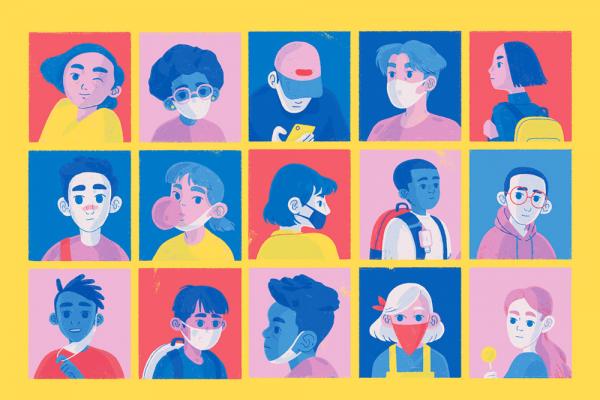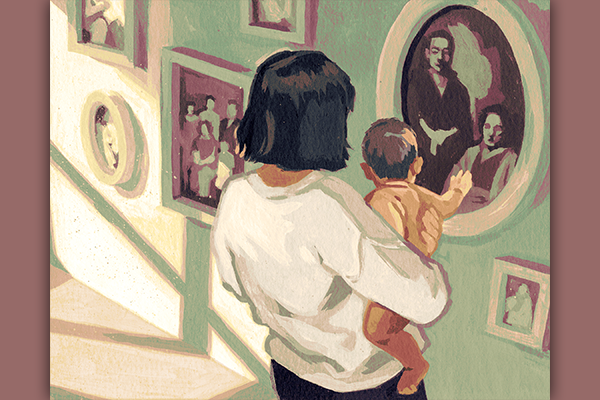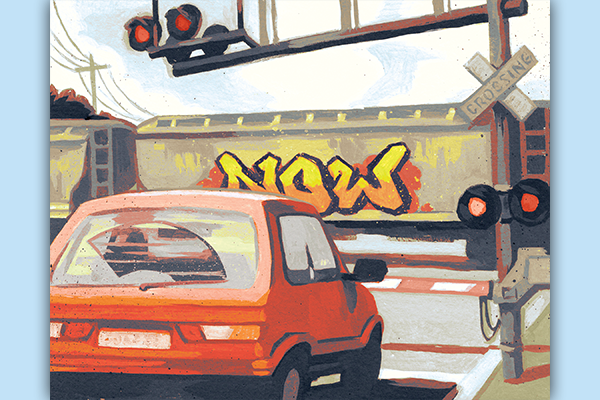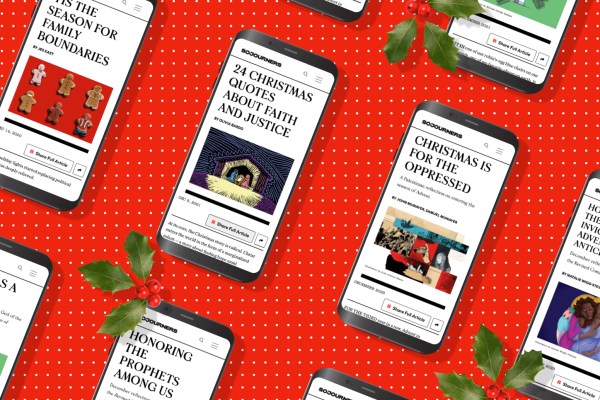EACH SPRING, I plan how to survive the summer. Without the school-year routine, our family leans on relatives, friends, summer camps, and cobbled-together vacation time to get our kids through. But this year, everything stopped: In a pandemic, you can’t visit Grandma or drop off the toddler for a playdate. If raising children takes a village, our village has been scattered. And while the nation collectively experiences this ongoing trauma, parents are attempting to shepherd our children through the same.
A large part of parenting is risk assessment—a constant cost-benefit analysis of how the decisions you make will affect your children for the rest of their lives. When I was pregnant with my third child, now 1, I read Emily Oster’s Cribsheet: A Data-Driven Guide to Better, More Relaxed Parenting, from Birth to Preschool to alleviate the added anxiety. Oster, an economics professor at Brown University, correctly observes that with constantly changing internet recommendations on everything from breastfeeding to screen time, “there is reassurance in seeing the numbers for yourself.” She lays out the scientific data so parents can make informed decisions; for me, it offered confidence—and a rare sense of control.
But that sense of security goes out the window in a pandemic, unforeseen economic collapse, and necessary reordering of our institutional constants. Parents face new risks with precious little, and everchanging, data to guide our analysis. The most common fear shared by parents I’ve spoken to is that our kids won’t be OK—that in trying to find the balance between naked truthfulness and parental protectionism, we’ll lean too heavily to one side, that the wrong decisions will leave lasting marks that follow them into adulthood.
“I don’t know what the world is going to look like. Will I have the wisdom and the capacity and the ability to help guide her through?” Susi McCrea tells me. When we spoke, McCrea was 32 weeks pregnant and living in northeast Washington, D.C., with her husband, Christopher, who was recently laid off, and 1-year-old daughter Katja.
“Will we be able to help [Katja] build the resilience that she needs for something that’s so full of uncertainty—and maybe just a really uncertain world for quite some time—without instilling a lot of fear?”
Those left behind
IT’S THE QUESTION all parents—and educators, youth ministers, counselors, and other caregivers—are asking. Just as previous generations have been defined by crises and technological breakthroughs, the coronavirus pandemic and the structures it toppled will affect the way this generation perceives the world, experiences security, relates to God, and understands their faith.
“One thing we do know from previous generations [is] these crises are foundational,” says Ruth Igielnik, senior researcher on the demographics and social change team at Pew Research. A crisis or trauma has a clear before and after. Lives are completely changed.
We also know the impacts of that change are not evenly distributed. “Don’t worry about teaching them,” went the refrain among many teachers and parents in the first month of our global homeschooling experiment. “No one is ahead or behind right now.” While comforting, it’s a false premise. Many children living in poverty and in rural communities couldn’t access online curricula. Some children of essential workers also lost easy access to their parents, who sequestered themselves from their families. Black children saw a disproportionate number of their loved ones test positive and die from the coronavirus and continue to live the daily trauma of police violence that targets people who look like them. And millions of children are experiencing the upheaval of one or both parents without jobs, as unemployment surged to 14.7 percent in April, the highest level since the Great Depression.
Of course, the data that would begin to paint a picture of how these manifold crises impact generational behavior doesn’t exist yet; researchers have yet to define our newest generation. In determining 1996 as the cutoff year between Millennials and their Gen Z successors, Pew considered that Millennials can remember a before and after 9/11, explains Igielnik—for example, a time before TSA, airport screenings, “enhanced border security,” and unending extensions of the 2001 Authorization for Use of Military Force—while for Gen Z, these have always been the norm.
Likewise, “Gen Z will know a world before and after the pandemic and the financial crisis,” Igielnik says. Our younger kids, those born after 2014 or so, will not.
Doing church
THIS MEANS THAT young kids might not see anything unusual in experiencing church as a Sunday morning livestream—a reality that could catalyze our efforts to reimagine what we call “church.”
“The first week we did Communion, all I had in my house were Cheerios and cranberry juice,” Almeda Wright tells me. Wright is an associate professor of religious education at Yale Divinity School who focuses in part on adolescent spiritual development. She’s also mom to an 18-month-old. Wright says members of her current worshiping community would likely look askance if they saw her daughter fiddling with the elements. But at home, they can experience Communion together in a casual, even playful way. “I wonder if, going forward, there will be less of the kind of hands-off, ‘this is only for adults’ that some traditions have around the major liturgical traditions of the congregation,” Wright says.
Conversations about what makes a virtual religious gathering valid have been and will continue to be debated—just type “virtual Communion” into Twitter’s search bar. And the ways our churches are forced to adapt will have an impact on how kids who choose to stay in the church approach those questions. As Alison Lytton Yeung, a mom of a 22-month-old and 1-month-old twins in Hoboken, N.J., puts it: “How do we maintain faith as something that we do in community when we are not doing anything in community?” She’s not sure when the family will feel comfortable returning to Sunday school or other church activities.
“We’ve been having to wrestle with what the role of the faith community is and will be going forward,” Wright says, pointing to the dramatic decline of church membership over the past couple of generations. “The pandemic is kind of hastening us to have that conversation.”
Dante Stewart, a writer, seminarian, and father to 2-year-old Asa, says compounding crises have forced the church to look beyond membership models and ask how it’s really serving people. “Our first question to ask is: How are image-bearers feeling unloved and how can we partner with them to make them feel loved?” Stewart says. The pandemic has highlighted relational, economic, racial, and spiritual crises, and the church must respond. “For me, Christians showing up in this moment means that we figure out how to create a more loving and just world, and wherever people feel unloved”—personally, socially, religiously, economically, politically—“we do whatever we can to create a more loving and just society.”
At the height of a nationwide uprising in the wake of the killings of George Floyd, Breonna Taylor, Rayshard Brooks, and so many more Black people at the hands of police, faith communities became way stations for people protesting police brutality. In late May, Holy Trinity Lutheran Church in South Minneapolis quickly transformed its closed sanctuary into a medic station for protesters wounded with tear gas or rubber bullets. In Washington, D.C., where churches and temples line 16th Street N.W. all the way from the Maryland border to the White House, faith communities have met protesters with masks, water, hand sanitizer, and even meals. Volunteers were using the patio of St. John’s Episcopal Church to serve protesters when militarized police cleared the park with tear gas ahead of Trump’s infamous photo-op.
Many of these churches and denominations are not new to this type of on-the-ground ministry—but their newfound visibility gives parents something tangible, a physical space to bring their children, clad in masks and toting homemade signs. “Honestly, maybe it’s an opportunity for some more powerful experiences, especially for older kids, being able to see in a more active way the practical outplay of people being Jesus’ hands and feet,” McCrea says.
Our collective work
SOME HAVE BEGUN to prognosticate on what norms will define “the COVID generation”—online school or church, more common digital relationships, technology that will render everyday transactional touch unnecessary, the death of the open workspace (thanks be to God). But Abby Wong-Heffter, a child and family therapist focused on trauma and affiliate faculty member at the Seattle School of Theology and Psychology, isn’t so sure.
Wong-Heffter points to the return to community after the 1918 influenza and more recent Ebola outbreaks, and predicts: “We come out on the other side and we’re so much more inclined toward connection and toward physical relationship with each other.” That connection, in community, could be what helps us heal. “When there’s a collective trauma, the response also has to be communal,” says Wong-Heffter. “So much of a way that we go about healing is individual, but with a collective experience, we usually need some way to come together in a large group for that healing to happen.” Schools, neighborhood associations, churches—these could be the places where we gather to mourn what we lost, but also to reimagine what comes next.
Stewart says the church can lean into the charism of Jesus as healer to begin that process in a holistic way—focusing on spiritual and structural healing—and that young people should be part of that healing process. “Often times, we talk about young people rather than allowing young people to talk about themselves,” Stewart, who previously taught middle schoolers, says. “To connect with young people, you have to give space for them to shape a world for themselves and be someone who comes alongside, using whatever tools that you can to encourage them.”
Having honest, age-appropriate conversations with children about what’s happening around them is also important for their development through crisis. They’re inundated with messages, particularly in a season of heightened screen time, about coronavirus spikes, police brutality, election fearmongering, and more.
“If we learned nothing else from 9/11, watching the planes go into the towers over and over and over again did something to our mental health,” Wright says. “It’s the same thing with a lot of the videos of police brutality and the most recent murder of George Floyd.”
Along with conversation and offering opportunities to engage—even if just hanging a hand-drawn rainbow in the window for passersby or decorating a “Black Lives Matter” sign—Wright says spiritual formation—engaging in sensory prayer, prayer walks, family Bible studies—can help families find balance in ways that perhaps weren’t possible amid our pre-COVID packed schedules. “I think one of the things that [this generation] is learning through this pandemic, and we’ll probably learn through the rest of 2020, is the gift of adaptability,” Wright says. “And I think that applies to their social lives and their emotional health, but also to their spiritual well-being.”
The after
IN EARLY JUNE, a friend and I arranged for our daughters, both age 6, to have a “socially distanced playdate.” Their facemasks quickly fell off as they bounded around the yard, digging in dirt and making a castle out of sticks, pinecones, and daffodils. It was painful to watch them forget and then repeatedly remember the directive to “keep distance!” after months of only FaceTiming. My friend and I discussed school reopening, debated the safety of taking the kids with us to the protests near the White House, and tried to forecast how long we—the collective we—could keep doing things this way.
In We Live for the We: The Political Power of Black Motherhood, journalist Dani McClain wonders whether her young daughter will see society “collectively pull ourselves back from the brink of extinction and bring about a renaissance, a social reordering that benefits more of us” or find herself in “a postapocalyptic landscape similar to something out of an Octavia Butler novel.” And either way, asks McClain, “How will I explain the choices I’ve made as an individual, the choices made by the communities we belong to, the choices made by the governments and corporations that have influence over our lives?”
McClain wrote this in 2019, but parents today know the feeling: How will we explain our choices and those of our leaders in this time?
For now, we’re readying ourselves for the long run: from preparing children for a drastically altered school year, to making plans for socially distanced family holidays, to having difficult and age-appropriate conversations about our country’s racist institutions as monuments to our failures come toppling down. There’s little time for existential dread. But we’re also eagerly awaiting the after—not necessarily for a return to normal, but for a season of healing and settling into, and helping shape, what this new reality is for ourselves and our children.
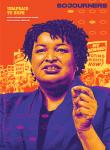
Got something to say about what you're reading? We value your feedback!
